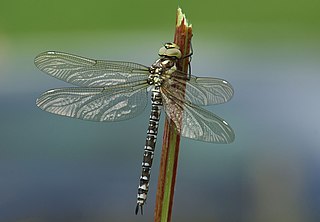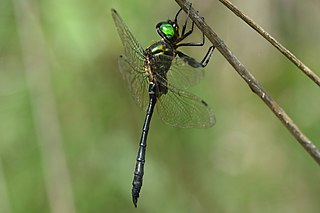
Odonata is an order of predatory flying insects that includes the dragonflies and damselflies. The two groups are distinguished with dragonflies usually being bulkier with large compound eyes together and wings spread up or out at rest, while damselflies are usually more slender with eyes placed apart and wings folded together along body at rest. Adult odonates can land and perch, but rarely walk.

Damselflies are flying insects of the suborder Zygoptera in the order Odonata. They are similar to dragonflies but are usually smaller and have slimmer bodies. Most species fold the wings along the body when at rest, unlike dragonflies which hold the wings flat and away from the body. Damselflies have existed since the Late Jurassic, and are found on every continent except Antarctica.

The chasers, darters, skimmers and perchers and their relatives form the Libellulidae, the largest family of dragonflies. It is sometimes considered to contain the Corduliidae as the subfamily Corduliinae and the Macromiidae as the subfamily Macromiinae. Even if these are excluded, there remains a family of over 1000 species. With nearly worldwide distribution, these are almost certainly the most often seen of all dragonflies.

Aeshna, or the mosaic darners, is a genus of dragonflies from the family Aeshnidae. Species within this genus are generally known as "hawkers" or "darners".

The red-veined darter or nomad is a dragonfly of the genus Sympetrum.

Corduliidae, also knowns as the emeralds, emerald dragonflies, or green-eyed skimmers, is a family of dragonflies. These dragonflies are usually black or dark brown with areas of metallic green or yellow, and most of them have large, emerald-green eyes. The larvae are black, hairy-looking, and usually semiaquatic. This family include species called "baskettails", "emeralds", "sundragons", "shadowdragons", and "boghaunters". They are not uncommon and are found nearly worldwide, but some individual species are quite rare. Hine's emerald dragonfly, for example, is an endangered species in the United States.

Somatochlora, or the striped emeralds, is a genus of dragonflies in the family Corduliidae with 42 described species found across the Northern Hemisphere.

Lestes is a genus of damselfly in the family Lestidae. The family hold their wings at about 45 degrees to the body when resting. This distinguishes them from most other species of damselflies which hold the wings along, and parallel to, the body when at rest.

Macromia is a genus of large dragonflies in the family Macromiidae. Species of the genus Macromia are commonly known as river cruisers from their habit of cruising long distances along river banks. Most species occur in the tropical Australasian region, with one species being found in Europe , and a few species occurring in North America.

Thaumatoneura inopinata is a species of damselfly, sometimes called the cascade damselfly or giant waterfall damsel, and the only member of the genus Thaumatoneura. It is unusual in flying among the falling water and spray from waterfalls in moist tropical or subtropical forests in Costa Rica.

Pantala is a genus of dragonfly in the family Libellulidae commonly called the rainpool gliders. They are found almost worldwide. Species of Pantala are medium-sized to large, dull orange-yellow dragonflies.

Brechmorhoga is a genus of dragonfly in the Libellulidae family. Members of this genus are commonly called clubskimmers because of the widening abdominal segments much like the clubtails.

The genus Epiophlebia is the sole member of the family Epiophlebiidae, which is itself the sole living representative of the Epiproctan infraorder Epiophlebioptera, and it contains only three species. The first two species were historically placed in their own suborder Anisozygoptera, considered intermediate between dragonflies and damselflies, mainly because the hind wings are very similar in size and shape to the forewings and held back over the body at rest, as in damselflies. It has more recently been recognized that the genus Epiophlebia shares a more recent ancestor with dragonflies, and the group has accordingly been reclassified as an infraorder within the dragonflies. Very recently a third species, Epiophlebia sinensis, has been described from Heilongjiang province in northeast China, bridging Epiophlebia distribution gap between Nepal and Japan. A fourth species has been claimed from larval material from South China, but this is not universally accepted. Epiophlebia species are a freshwater indicator of a river ecosystem health. A study that has been conducted on the head anatomy of Epiophlebia has verified the presence of 41 muscles in the head of the larva. Like in true dragonflies (Anisoptera) the aquatic nymphs breathe through a rectal chamber, but jet propulsion has yet to be documented. Epiophlebia species are a representative of a dragonfly fauna which originated during the Jurassic period on the rising continent of Eurasia.
Odonata are insects with an incomplete metamorphosis (hemimetabolous). The aquatic larva or nymph hatches from an egg, and develops through eight to seventeen instars before leaving the water and emerging as the winged adult or imago.

Lestoidea is a genus of damselflies in the family Lestoideidae, commonly known as bluestreaks. Its species are endemic to north-east Queensland, Australia, where they inhabit rainforest streams.

Apocordulia is a genus of dragonflies in the family Austrocorduliidae, endemic to the Murray-Darling Basin in eastern Australia.
Chalcopteryx is a genus of damselflies in the family Polythoridae. There are about five described species in Chalcopteryx.

Zenithoptera fasciata, also known as the rainforest bluewing is a species of dragonfly native to much of the northern half of South America, as well as southern portions of Central America. The species has in the past been known by additional taxonomic names, including: Libellula fasciata, Libellula americana, and Libellula violacea.
Brechmorhoga praecox, the slender clubskimmer, is a species of skimmer in the dragonfly family Libellulidae. It is found in Central America and South America.
















